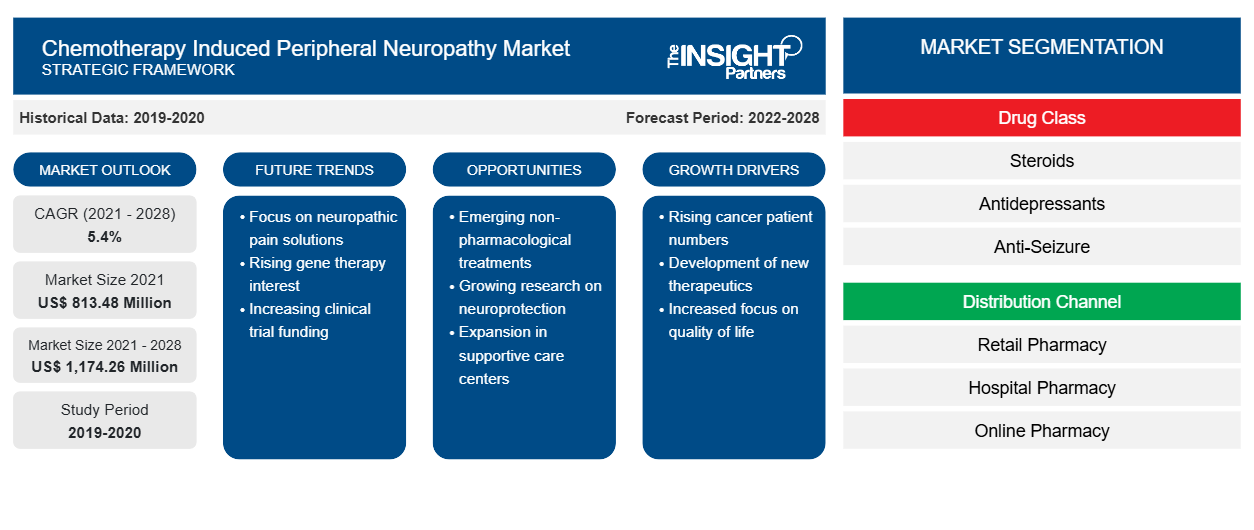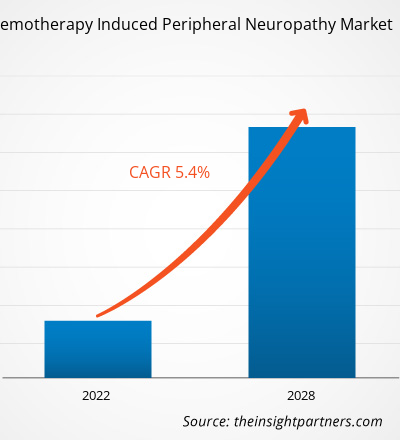[研究报告] 化疗引起的周围神经病变市场预计将从 2021 年的 8.1348 亿美元增至 2028 年的 11.7426 亿美元;预计2021 年至 2028 年的复合年增长率为 5.4%。
化疗引起的周围神经病变是抗肿瘤药物最常见的副作用之一。临床上,它主要是一种感觉神经病变,可能伴有不同强度和持续时间的运动和自主神经变化。由于化疗引起的周围神经病变在癌症患者中发病率很高,因此它对癌症患者和幸存者以及他们的医疗保健提供者来说都是一个主要问题,特别是因为目前还没有单一有效的方法来预防它;此外,治疗这种综合症的可能性有限。
定制此报告以满足您的需求
您可以免费定制任何报告,包括本报告的部分内容、国家级分析、Excel 数据包,以及为初创企业和大学提供优惠和折扣
- 获取此报告的关键市场趋势。这个免费样品将包括数据分析,从市场趋势到估计和预测。
该报告提供了化疗引起的周围神经病变( CIPN ) 市场的见解和深入分析,强调了市场趋势、技术进步和市场动态。它还提供了全球主要市场参与者的竞争格局分析。此外,该报告还包括 COVID-19 大流行对所有地区化疗引起的周围神经病变市场的影响。这场大流行在世界范围内造成了公共卫生危机和经济危机。由于癌症筛查、咨询和治疗的规律性,大流行之前化疗引起的周围神经病变的全球市场不断增长。第一波 COVID-19 扰乱了肿瘤病例的咨询、随访和筛查。此外,在 COVID-19 大流行早期,临床试验和患者药物供应的中断影响了化疗引起的周围神经病变市场最关键的领域。重点转向及时治疗 COVID-19 导致对其他各种医疗状况的忽视。此外,癌症病例发现率和化疗次数的减少也阻碍了对化疗引起的周围神经病变的诊断和治疗的需求。
市场洞察
癌症患病率上升推动化疗诱发周围神经病变市场增长
癌症是全球死亡的主要原因。根据世界卫生组织 (WHO) 的数据,2019 年,癌症是 183 个国家 70 岁以下人群的第一大死亡原因,也是 123 个国家各年龄段人口的第四大死亡原因。此外,根据世卫组织 2021 年 3 月发布的数据,不同类型的癌症在 2020 年导致约 1000 万人死亡。
2020 年全球最常见的癌症类型
- 这个免费样品将包括数据分析,从市场趋势到估计和预测。
癌症发病率的不断上升给全世界的医疗系统带来了负担,同时也增加了对化疗的需求。化疗引起的周围神经病变是神经毒性抗癌药物的常见不良反应,例如铂类衍生药物(顺铂和奥沙利铂)、纺锤体毒素[紫杉烷(紫杉醇和多西他赛)、长春花生物碱、长春新碱、埃博霉素和艾日布林]、硼替佐米和沙利度胺。化疗引起的周围神经病变的高发病率引起了人们对癌症患者和幸存者及其医疗保健提供者的担忧,尤其是因为没有单一有效的方法来预防这种疾病。
《国际疼痛研究协会杂志》的一项研究表明,化疗后第一个月化疗引起的周围神经病变患病率为 68.1% (57.7–78.4),第三个月患病率为 60.0% (36.4–81.6),第六个月及以后患病率为 30.0% (6.4–53.5)。因此,随着癌症患病率的上升,化疗引起的周围神经病变发病率也随之上升,推动了化疗引起的周围神经病变市场的增长。
基于药物类别的见解
根据药物类别,化疗引起的周围神经病变市场分为类固醇、抗抑郁药、抗癫痫药和麻醉药。2021 年,类固醇药物占据了最大的市场份额。预测期内,抗癫痫药物的复合年增长率预计将达到 6.2%,是最快的。
基于分销渠道的洞察
根据分销渠道,化疗引起的周围神经病变市场分为医院药房、零售药房和在线药房。2021 年,医院药房占据了最大的市场份额。此外,预计零售药房在 2021-2028 年期间的复合年增长率最高,为 5.9%。
化疗引起的周围神经病变 (CIPN) 市场参与者专注于采用产品发布和扩展等有机策略来扩大其全球影响力和产品组合,并满足日益增长的需求。
化疗引起的周围神经病变市场报告范围
按地理位置
根据地域划分,化疗引起的周围神经病变市场分为北美(美国、加拿大和墨西哥)、欧洲(英国、德国、法国、意大利、西班牙和欧洲其他地区)、亚太地区(中国、日本、印度、澳大利亚、韩国和亚太其他地区)、中东和非洲(阿联酋、沙特阿拉伯、南非和中东和非洲其他地区)以及南美洲和中美洲(巴西、阿根廷和南美洲和中美洲其他地区)。
公司简介
- 丽晶制药有限公司
- 旭化成制药株式会社
- 诺华
- Makscientific有限责任公司
- Wex 制药公司
- Sova 制药公司
- Kineta 公司
- Aptinyx 公司
- Apexian Pharmaceuticals, Inc.
- Winsantor 公司
化疗引起的周围神经病变报告范围
| 报告属性 | 细节 |
|---|---|
| 2021 年市场规模 | 8.1348亿美元 |
| 2028 年市场规模 | 11.7426亿美元 |
| 全球复合年增长率(2021 - 2028) | 5.4% |
| 史料 | 2019-2020 |
| 预测期 | 2022-2028 |
| 涵盖的领域 | 按药物类别
|
| 覆盖地区和国家 | 北美
|
| 市场领导者和主要公司简介 |
|
- 历史分析(2 年)、基准年、预测(7 年)及复合年增长率
- PEST 和 SWOT 分析
- 市场规模价值/数量 - 全球、区域、国家
- 行业和竞争格局
- Excel 数据集



Report Coverage
Revenue forecast, Company Analysis, Industry landscape, Growth factors, and Trends

Segment Covered
This text is related
to segments covered.

Regional Scope
North America, Europe, Asia Pacific, Middle East & Africa, South & Central America

Country Scope
This text is related
to country scope.
常见问题
The chemotherapy induced peripheral neuropathy market majorly consists of the players such as Regenacy Pharmaceuticals, Inc, Asahi Kasei Pharma Corporation., Novaremed, Makscientific, Llc, Wex Pharmaceuticals Inc., Sova Pharmaceuticals, Inc., Kineta, Inc., Aptinyx Inc., Apexian Pharmaceuticals, Inc., and Winsantor, Inc. amongst others.
Chemotherapy-induced peripheral neuropathy (CIPN) is one of the most frequent side effects caused by antineoplastic agents. Clinically, CIPN is a mostly sensory neuropathy that may be accompanied by motor and autonomic changes of varying intensity and duration. Due to its high prevalence among cancer patients, CIPN constitutes a major problem for both cancer patients and survivors as well as for their health care providers, especially because, at the moment, there is no single effective method of preventing CIPN; moreover, the possibilities of treating this syndrome are very limited.
The chemotherapy induced peripheral neuropathy market, by drug class, is bifurcated into steroids, antidepressants, anti-seizure medicines, and narcotics. In 2021, the steroids segment held the largest share of the market. The anti-seizure medicines segment of the chemotherapy induced peripheral neuropathy market is expected to witness growth in its demand at the fastest CAGR during the forecast period.
The factors that are driving and restraining factors that will affect the chemotherapy induced peripheral neuropathy market in the coming years. Major factors driving the market growth include the increasing prevalence of cancer and increasing preference for chemotherapy. Additionally, the growing clinical trials for chemotherapeutic drugs is likely to emerge as a significant future trend in the market during the forecast period. However, lack of consolidated guidelines for chemotherapy hamper the chemotherapy induced peripheral neuropathy market growth.
Trends and growth analysis reports related to Life Sciences : READ MORE..
The List of Companies - Chemotherapy Induced Peripheral Neuropathy Market
- REGENACY PHARMACEUTICALS, INC
- ASAHI KASEI PHARMA CORPORATION
- NOVAREMED
- MAKSCIENTIFIC, LLC
- WEX PHARMACEUTICALS INC
- SOVA PHARMACEUTICALS, INC
- KINETA, INC.
- APTINYX INC.
- APEXIAN PHARMACEUTICALS, INC.
- WINSANTOR, INC
The Insight Partners performs research in 4 major stages: Data Collection & Secondary Research, Primary Research, Data Analysis and Data Triangulation & Final Review.
- Data Collection and Secondary Research:
As a market research and consulting firm operating from a decade, we have published and advised several client across the globe. First step for any study will start with an assessment of currently available data and insights from existing reports. Further, historical and current market information is collected from Investor Presentations, Annual Reports, SEC Filings, etc., and other information related to company’s performance and market positioning are gathered from Paid Databases (Factiva, Hoovers, and Reuters) and various other publications available in public domain.
Several associations trade associates, technical forums, institutes, societies and organization are accessed to gain technical as well as market related insights through their publications such as research papers, blogs and press releases related to the studies are referred to get cues about the market. Further, white papers, journals, magazines, and other news articles published in last 3 years are scrutinized and analyzed to understand the current market trends.
- Primary Research:
The primarily interview analysis comprise of data obtained from industry participants interview and answers to survey questions gathered by in-house primary team.
For primary research, interviews are conducted with industry experts/CEOs/Marketing Managers/VPs/Subject Matter Experts from both demand and supply side to get a 360-degree view of the market. The primary team conducts several interviews based on the complexity of the markets to understand the various market trends and dynamics which makes research more credible and precise.
A typical research interview fulfils the following functions:
- Provides first-hand information on the market size, market trends, growth trends, competitive landscape, and outlook
- Validates and strengthens in-house secondary research findings
- Develops the analysis team’s expertise and market understanding
Primary research involves email interactions and telephone interviews for each market, category, segment, and sub-segment across geographies. The participants who typically take part in such a process include, but are not limited to:
- Industry participants: VPs, business development managers, market intelligence managers and national sales managers
- Outside experts: Valuation experts, research analysts and key opinion leaders specializing in the electronics and semiconductor industry.
Below is the breakup of our primary respondents by company, designation, and region:

Once we receive the confirmation from primary research sources or primary respondents, we finalize the base year market estimation and forecast the data as per the macroeconomic and microeconomic factors assessed during data collection.
- Data Analysis:
Once data is validated through both secondary as well as primary respondents, we finalize the market estimations by hypothesis formulation and factor analysis at regional and country level.
- Macro-Economic Factor Analysis:
We analyse macroeconomic indicators such the gross domestic product (GDP), increase in the demand for goods and services across industries, technological advancement, regional economic growth, governmental policies, the influence of COVID-19, PEST analysis, and other aspects. This analysis aids in setting benchmarks for various nations/regions and approximating market splits. Additionally, the general trend of the aforementioned components aid in determining the market's development possibilities.
- Country Level Data:
Various factors that are especially aligned to the country are taken into account to determine the market size for a certain area and country, including the presence of vendors, such as headquarters and offices, the country's GDP, demand patterns, and industry growth. To comprehend the market dynamics for the nation, a number of growth variables, inhibitors, application areas, and current market trends are researched. The aforementioned elements aid in determining the country's overall market's growth potential.
- Company Profile:
The “Table of Contents” is formulated by listing and analyzing more than 25 - 30 companies operating in the market ecosystem across geographies. However, we profile only 10 companies as a standard practice in our syndicate reports. These 10 companies comprise leading, emerging, and regional players. Nonetheless, our analysis is not restricted to the 10 listed companies, we also analyze other companies present in the market to develop a holistic view and understand the prevailing trends. The “Company Profiles” section in the report covers key facts, business description, products & services, financial information, SWOT analysis, and key developments. The financial information presented is extracted from the annual reports and official documents of the publicly listed companies. Upon collecting the information for the sections of respective companies, we verify them via various primary sources and then compile the data in respective company profiles. The company level information helps us in deriving the base number as well as in forecasting the market size.
- Developing Base Number:
Aggregation of sales statistics (2020-2022) and macro-economic factor, and other secondary and primary research insights are utilized to arrive at base number and related market shares for 2022. The data gaps are identified in this step and relevant market data is analyzed, collected from paid primary interviews or databases. On finalizing the base year market size, forecasts are developed on the basis of macro-economic, industry and market growth factors and company level analysis.
- Data Triangulation and Final Review:
The market findings and base year market size calculations are validated from supply as well as demand side. Demand side validations are based on macro-economic factor analysis and benchmarks for respective regions and countries. In case of supply side validations, revenues of major companies are estimated (in case not available) based on industry benchmark, approximate number of employees, product portfolio, and primary interviews revenues are gathered. Further revenue from target product/service segment is assessed to avoid overshooting of market statistics. In case of heavy deviations between supply and demand side values, all thes steps are repeated to achieve synchronization.
We follow an iterative model, wherein we share our research findings with Subject Matter Experts (SME’s) and Key Opinion Leaders (KOLs) until consensus view of the market is not formulated – this model negates any drastic deviation in the opinions of experts. Only validated and universally acceptable research findings are quoted in our reports.
We have important check points that we use to validate our research findings – which we call – data triangulation, where we validate the information, we generate from secondary sources with primary interviews and then we re-validate with our internal data bases and Subject matter experts. This comprehensive model enables us to deliver high quality, reliable data in shortest possible time.


 获取此报告的免费样本
获取此报告的免费样本